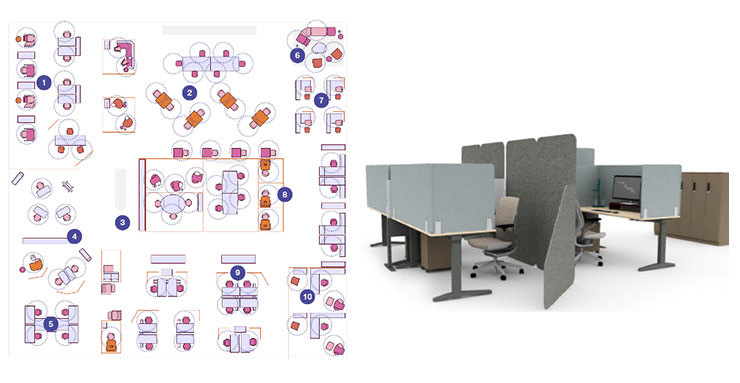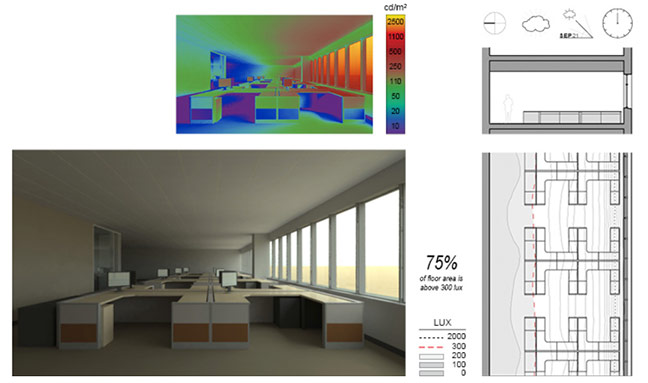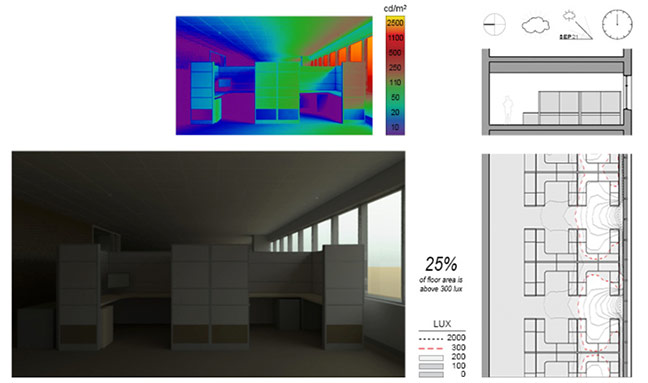Post-Covid workplace design: what about daylight and views?

COVID-19 shows no signs of disappearing1. We’re going to have to adapt our spaces and ways of life as a result. Many companies are rethinking their office space to ensure that their employees can return with peace of mind. Therefore, we are seeing new workplace layouts designed to minimize health risks. However, these arrangements may have significant implications for other aspects of occupants’ wellbeing. In some cases, they may even reduce comfort and performance. This is particularly true for visual comfort, which can be hugely impacted by office layout.
Returning to partitions to limit infection risks
I recently stumbled upon a white paper published by Steelcase2 describing office layouts and furniture designed to prevent disease transmission. How does this play out? Specifically, by using dividers like protective screens, partitions or other barriers “in front of, beside and behind people” in adjoining offices or an open-plan office. Increasing the height and width of the partitions is also recommended to reduce exposure. These arrangements are recommended as part of a short-term plan when physical distancing between employees cannot be guaranteed.

Example of “post-COVID” office layout and furniture (source: Steelcase)
Managing the flow of people is another recommended strategy to limit mingling and contact. As such, partitions can be used to mark the movement of traffic, in addition to or in the absence of floor markings.
Implications for daylight penetration and luminous ambiance
While the office layout solutions described above can help limit the risks of infection, they also impact the influx of natural light in the workplace.
The images below, for instance, show how indoor partitions reduce the levels of natural light in workstations and impact the perceived luminous ambiance. Spatial daylight autonomy falls from 75% to 25% and the space seems less bright and spacious, with a marked effect on the visual experience.

Office space without partitions

Office space with partitions - Source: http://patternguide.advancedbuildings.net/
Implications for views of the outdoors
Similarly, office layout has a significant effect on access to views from different workstations. Depending on their height, opaque partitions may cut lines of vision, which are considered a key criterion for the quality of views under LEED and DGNB standards. The taller the partitions, the bigger their impact — and the more they limit the sense of connection with the outdoors, as shown in the image above.
If partitions are destined to become standard in our offices once again, glass partitions can improve the visual experience to some extent, albeit with other implications in terms of acoustics. In any case, it’s critical to maximize the size of windows to ensure natural light and access to views for occupants. However, larger windows do require solutions to manage heat gain and glare.
Conclusions
The pandemic has given us the opportunity to rethink the spaces in which we live and work to make them more “human.” Yet individual wellbeing is the result of multiple physiological and psychological aspects, including a sense of security, the visual and acoustic experience, thermal comfort and personal and social factors. Some employees will be happy to work in a partitioned workspace, prioritizing health above all, while others will never fully enjoy working in this type of space due to a lack of natural light and connection to the outdoors.
How, then, can companies satisfy their workforce by offering a workplace that’s healthier, more comfortable and more conducive to creativity and performance, all at the same time? This is a huge challenge for designers and companies, and one I won’t attempt to solve here. I simply wish to point out that basing the entire design of a space on one aspect (i.e., preventing infection) could have negative effects in the long run. We must consider human beings in all their complexity and build from a holistic approach if we wish to make our buildings suitable for people.
- https://www.lesechos.fr/industrie-services/pharmacie-sante/pourquoi-le-coronavirus-pourrait-ne-jamais-disparaitre-1232233
- Navigating What’s Next: The Post-COVID Workplace, Steelcase, 2020